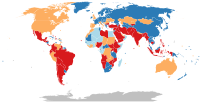
Photo from wikipedia
A pneumonia of unknown cause was detected in Wuhan, China, and reported to the WHO Country Office in China on 31 December 2019. Labelled initially as a coronavirus, then latterly… Click to show full abstract
A pneumonia of unknown cause was detected in Wuhan, China, and reported to the WHO Country Office in China on 31 December 2019. Labelled initially as a coronavirus, then latterly Covid-19, the outbreak was declared by the World Health Organisation (WHO) as a Public Health Emergency of International Concern on 30 January 2020 and a pandemic on 11th March 2020. As Covid-19 swept around the globe, Health Professions’ educators (HPEs) have had to adapt their campus-based and clinical educational provision in a context of rapidly changing circumstances and ongoing uncertainty. Different countries varied in the speed and nature of their responses to the spread of Covid-19. Our context of Singapore has well-developed protocols for outbreak preparation (MOH 2019) and on 7th February 2020 the Ministry of Health (MOH) risk assessed COVID-19 as “DORSON Orange” (Disease Outbreak Response System Condition) (MOH 2020). This introduced precautionary measures to minimise the risk of transmission of the virus in the country (e.g., daily health checks, stringent contact tracing and quarantining, enhanced focus on hygiene and protection, and segregating groups to contain disease spread). The specific implications of these measures for medical education and teaching were that: students in Singapore’s three medical schools were taken out of clinical environments; students could not be taught on a whole or even half class basis; there was reduced availability of clinicians to participate in educational activities, and clinicians who were available could not always attend campus in person because of infection control measures. Our particular responses to these constraints were multiple. These included: shifting our pedagogy from face-to-face Team-Based Learning (TBL: Rajalingam et al. 2018) to e-TBL delivered online; reducing face-to-face class sizes and running classes repeatedly; and introducing some novel simulations to prepare final year students for postgraduate training. While undoubtedly the pedagogic, technical and operational aspects of what we did will be of interest, particularly to those with a digital learning interest, the focus of this editorial is not to tell you of our adaptations, or ask others to consider how they responded in these uncertain and volatile times. Instead, we position our response to unanticipated disruption as problem-posing rather than problem-solving (Biesta et al. 2019), and a potentially positive driver within the educational research space—if considered appropriately.
Journal Title: Advances in Health Sciences Education
Year Published: 2020
Link to full text (if available)
Share on Social Media: Sign Up to like & get
recommendations!